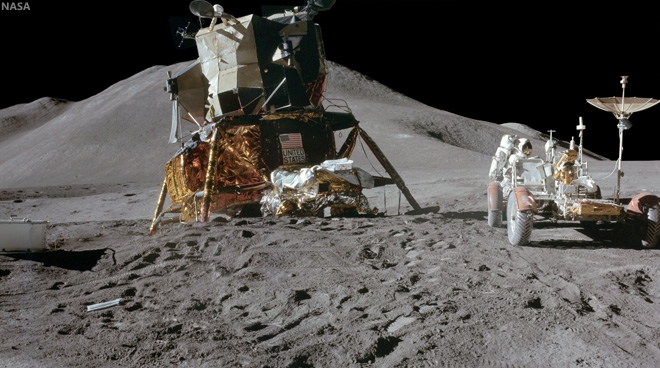David S. F. Portree
Wired
Bellcomm, Inc., based near NASA Headquarters in Washington, DC, was carved out of Bell Labs in 1962 to provide technical advice to NASA’s Apollo Program Director. The organization rapidly expanded its bailiwick to support nearly all NASA Office of Manned Space Flight advance planning.
In a January 1968 report, Bellcomm planners N. Hinners, D. James, and F. Schmidt proposed a mission series designed to fill a gap which they felt existed in NASA’s lunar exploration schedule between the first piloted Apollo lunar landing and later, more advanced Apollo Applications Program (AAP) lunar flights. The trio declared that their plan was “based upon a reasonable set of assumptions regarding hardware capability and evolution, an increase in scientific endeavor, launch rates, budgetary constraints, operational learning, lead times, and interaction with other space programs,” as well as “the assumption that lunar exploration will be a continuing aspect of human endeavor.”
To bridge the gap between early Apollo and AAP, they envisioned a series of 12 lunar missions in four phases.
Wired
Bellcomm, Inc., based near NASA Headquarters in Washington, DC, was carved out of Bell Labs in 1962 to provide technical advice to NASA’s Apollo Program Director. The organization rapidly expanded its bailiwick to support nearly all NASA Office of Manned Space Flight advance planning.
In a January 1968 report, Bellcomm planners N. Hinners, D. James, and F. Schmidt proposed a mission series designed to fill a gap which they felt existed in NASA’s lunar exploration schedule between the first piloted Apollo lunar landing and later, more advanced Apollo Applications Program (AAP) lunar flights. The trio declared that their plan was “based upon a reasonable set of assumptions regarding hardware capability and evolution, an increase in scientific endeavor, launch rates, budgetary constraints, operational learning, lead times, and interaction with other space programs,” as well as “the assumption that lunar exploration will be a continuing aspect of human endeavor.”
To bridge the gap between early Apollo and AAP, they envisioned a series of 12 lunar missions in four phases.
Read the full article, HERE.


2 comments:
Look at the angle of the LM relative to the horizontal in that first photo!
Was it really like that, or is that just an optical illusion caused by the angle of the camera and the terrain where the photographer is standing?
The highest angle of repose for any of the six lm landings, Apollo 17 encountered the most battered terrain of any of the basalt plain landing zones, so yes. It's kind of an optical illusion. There is a crater, a small one, just about where Cmdr. Scott was standing, with upslope continuing beyond the lm to the Mount Hadley massif beyond. Later during their EVA's, Scott and Irwin drove and walked quite a way up that slope, north or St. George's crater, and took a picture from the distance, looking back, which confirms this view of the terrain between the lander and the massif "piedmont," the Apennine Front, from Stations 7 and 6a. and that picture is an excellent illustration of the foreshortening loss of perspective in judging distances on the Moon, with human eyes used to refraction, a further horizon, etc.
That picture is AS15-84-11324HR.
There's an incredible amount of very recent study of the Apollo 15 LZ, using LROC laser and LROC WAC interferometry, and much more among the links and links, HERE.
Post a Comment